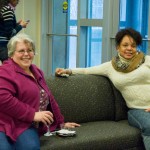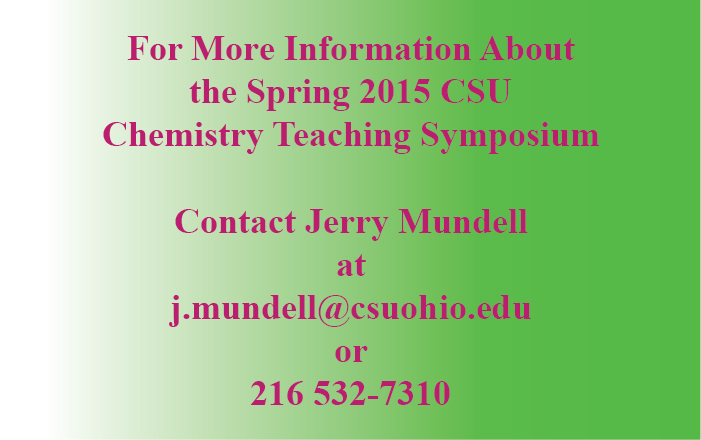The General Chemistry Teaching Symposium was held on March 13-15 2014 at Cleveland State University. Please click on a link below to see Abstracts of the presentations/posters, the Event Schedule, and the Photo Gallery.
Symposium Abstracts
Symposium Schedule of Events
Photo Gallery
Information on 2015 Symposium
Abstracts
Jason S. Overby
Atoms First and Adaptive Learning: A Practical Approach to Student Success in Chemistry
The atoms first approach to teaching chemistry is centered on building a story-like setting for general chemistry and focuses first on the conceptual side of the material. Current adaptive learning tools like SmartBook engage the student in a conceptual-centered approach to learning chemistry. This presentation will illustrate how the atoms first approach and adaptive learning are powerful implementations to getting students “to think like chemists” and succeed in chemistry.
Neocles B. Leontis , David Erickson, Andrew Torelli, Peter Blass
New Strategies for Constructivist Instruction in Chemistry
Molecular Workbench (MW) is a free and easy to use, on-line molecular dynamics (MD) simulation tool, embedded in a rich curricular authoring framework. It provides instructors with integrated tools to engage students through constructivist modeling and simulation in the study of important chemical phenomena. With MW, instructors can deploy rich activities that students can download, run, and modify on their own computers. Student creations can be uploaded for sharing and evaluation. We have identified barriers to constructivist pedagogy that must be overcome to achieve significant student learning gains. Students experience cognitive “overload” when first presented with open-ended modeling exercises. We have developed a new strategy we call “Break It to Make It.” Students are presented with working simulations of familiar phenomena and are challenged to modify or “break” them so the existing behavior no longer occurs. Then they modify selected parameters to “re-make” the simulation to produce new dynamic behaviors. Challenges deployed using this strategy include “breaking” exothermic reactions to make them endothermic (or exothermic in the reverse direction), “breaking” miscible liquid mixtures so they separate into immiscible phases, and “breaking” uniquely folded polymer chains so they unfold without changing temperature. After students gain experience with highly scaffolded modeling exercises, they are presented challenges requiring more creativity on their part. Examples will be presented including trapping molecules inside of cells or finding ways reduce the osmotic pressure of a solution. MW is especially suited for exploring challenging topics that are difficult for students to master using conventional “static,” book-based learning.
Neocles B. Leontis , David Erickson
Constructivist Instruction in Chemistry Using Molecular Workbench
Participants will learn to use Molecular Workbench (MW) with their students to deepen their understanding of important chemical phenomena through constructivist modeling and simulation. MW is a free and easy to use, on-line molecular dynamics (MD) simulation tool embedded in a rich curricular authoring framework that students can download, run, and modify on their own computers. Participants will learn to create working models and challenge their students to modify, “break,” and then “re-make” them to produce new dynamic behaviors and even solve chemical problems. MW is especially suited for exploring challenging topics that are difficult for students to master using conventional “static,” book-based learning. Participants should bring a list of challenging topics to work on in the workshop and we will help you.
Regan L. Silvestri
Lessons Learned Teaching General Chemistry via Video Teleconference
Teaching General Chemistry via a video teleconference format offers both challenges and opportunities that are unique to both the class format and the topic content. A video teleconference offering of a General Chemistry course can be a highly positive learning experience; the instructor need only approach the course with careful consideration of all of the potential advantages and potential pitfalls. Through our experience we have learned how to leverage the video conference format, exploiting associated technologies, to actually advance student learning. We would like to offer insights from our experience teaching General Chemistry via video teleconference.
Betsy Ratcliff , Mark Schraf
Effects of a Shorter Student Event Horizon in Prep Chem
Historical data indicates that within the first three weeks of class, we can identify those WVU students that lack either the motivation or the skill-set necessary to successfully complete our preparatory chemistry course. In order to more effectively remediate these students, we replaced the one-semester, 2 credit hour course with two consecutive back-to-back half-semester courses. Those students who do not earn an A, B, or C in the first half-semester are prevented from continuing on to the second half-semester. These students are encouraged to enroll in a college-skill “parachute” course instead of spending an entire semester on an unsuccessful effort. We report on the results of this project after two complete semesters.
Salah M. Blaih , James Durandetta
Mentoring in General Chemistry Laboratory: A College/High School Venture!
A joint chemistry program between Kent State University at Trumbull and local high schools is discussed. HS students and teachers were invited to participate in general chemistry labs. HS students were paired with KSU students enrolled in the general chemistry sequence. College students were to act as mentors to the HS students. All students were asked to work on an advance assignment in preparation for the upcoming lab and to provide a summary of the principles/procedures to be undertaken. Learning concepts such as active learning, peer-led team, and process oriented guided inquiry learning (POGIL) were emphasized throughout. The joint venture proved to be a valuable experience for both institutions.
Danaè R. Quirk Dorr
Leveraging Student Learning with the Flipped Classroom
Student assessment results indicate that student use of learning tools in the flipped classroom correlates with individual student learning styles and levels of achievement. Results obtained from flipped classroom assessments and survey data analysis will be presented in conjunction with flipped classroom model implementation strategies and best practices.
Demetra A. C. Czegan
Growing Crystals: Creating an Independent Research Experiment in the Undergrauate Inorganic Chemistry Lab.
Bal Barot
Flipping the classroom in Organic Chemistry
To free up class time, in the past we tried computer assisted assessment. Another strategy is flipping the classroom. Such strategy of flipping classrooms demands each student to spend more time to master a concept or a skill, as they would have otherwise. It involves prior planning and preparation. The content is made available before the class meeting and then during the class each student is required to ask questions, works on a problem, participates in the discussion and proves the mastery of the concept. This teaching strategy will be presented, with examples.
Lori Kraft
Comparison of Student Performance in Flipped and Traditional Chemistry Course
A section of Introductory and Analytical Chemistry (2820:111) was taught in a traditional classroom setting and in a flipped classroom. Each class was composed of about 15 non-majors. Both classes used clicker technology. The traditional classroom setting offered the content during the lecture time. Homework was completed outside of class time. The flipped classroom offered the content through short video segments viewed outside of class time. During class, these students reviewed concepts for the first 10 minutes and then completed chemistry problems in small groups. The flipped class performed about 7% better overall than the non-flipped class.
Lynne Divis
Hydrogen Bonding: A Guided Inquiry Activity for Pre-Nursing Majors
A guided inquiry activity has been designed for general, organic, and biological (GOB) chemistry students, helping them learn what structural features are necessary for hydrogen bonding to occur. The model shows molecular structures of molecules that can and cannot form hydrogen bonds. Students examine what elements are needed and what elements must be bonded to which. Students determine the criteria for hydrogen bonding to occur. Students decide whether hydrogen bonds are intermolecular or intramolecular and whether hydrogen bonds are bonds in the same sense as are ionic and covalent bonds. Finally, students practice identifying which molecules can form hydrogen bonds.
Back to Top of Page
Symposium Abstracts
Symposium Schedule of Events
Photo Gallery
SCHEDULE OF EVENTS
Thursday, March 13
8:00 AM-8:45 AM
Registration an Continental Breakfast of Coffee.
Juice, Fruit, and Pastry
Location: Main Classroom Atrium
Morning Sessions
Location: Main Classroom Auditorium
9:00 – 9:05 AM
Welcome Remarks: David Ball, Chair Chemistry Department, Meredith Bond, Dean of College of Science and Health Professions
9:05 – 9:45 AM
Jason Overby, College of Charleston, Atoms First and Adaptive Learning: A Practical Approach to Student Success in Chemistry.
10:00 – 10:30 AM
Paul Sampson, Kent State University, One Year On – An Update: Implementation of ALEKS Chemistry as an Assessment and Remediation Tool for General Chemistry.
10:40 – 11:10 AM
Regan Silvestri, Loraine County Community College, Lessons Learned Teaching General Chemistry via Video Teleconference
Lunch served in Main Classroom Atrium
11:30 – 12:45 PM
Afternoon Sessions
Location: Main Classroom Auditorium
1:00 – 1:45 PM
David Spurgeon, Director of Chemistry, McGraw-Hill Education, Publishing in the Digital Age
2:00 – 2:30 PM
Shadrick Paris, Ohio University, Employing Technology in the Classroom.
2:40 – 3:10 PM
Neocles Basil Leontis, Bowling Green State University, Active, Constructivist Instruction in Chemistry Using Molecular Workbench.
3:20 – 3:40 PM
Betsy Ratcliff, West Virginia University, Effects of a Shorter Student Event Horizon in Prep Chem.
3:50 – 4:20 PM
Demetra A. C. Czegan, Seton Hill University, Growing Crystals: Creating an Independent
Research Experience in the Undergraduate Inorganic Chemistry Lab
4:30 – 6:00 PM
Poster Session:
All attendees are invited to relax and enjoy wine and hors d’oeuvres during the poster session
Location: Main Classroom Atrium
Friday, March 14
8:30 AM – 5:00 PM
Registration an Continental Breakfast of Coffee, Juice, Fruit, and Pastry
Location: Main Classroom Atrium
8:30 – 9:50
Workshops:
Anne O’Connor, Cleveland State University, Teaching Technologies 101: Making Camtasia Teaching Videos, Using Kindle in the Classroom, Interactive Online Quizzes, and Pencasts.
Location: SI 341, Basic Science Building
Neocles Basil Leontis, Bowling Green State University, Molecular Workbench
Location: MC 102, Main Classroom
Jerry Mundell, Cleveland State University, The Wimba Application for Interactive Teaching in the Classroom and More
Location: SI 340, Basic Science Building
Christine Sell, Cleveland State University, How to Write a Grant Proposal
Location: MC 103, Main Classroom
General Meeting Room: Available for informal discussions
Location: MC 104, Main Classrooms
Morning Sessions
Location: Main Classroom Atrium
10:00 – 10:50 AM
George Kemper and Paul Orban, bhdp Architecture, What’s Driving the Future of Academic Laboratories?
11:00 – 11:30 AM
Salah Blaih, Kent State University and James Durandetta, Kent State University: Mentoring in General Chemistry Laboratory: A College/High School Venture
11:30 – 12:45 PM
Lunch served in Main Classroom Atrium
12:15 – 12:50 PM
Tour of New Freshman Teaching Labs
Afternoon Sessions
Location: Main Classroom Auditorium
1:00 – 1:45 PM
Danae Quirk Dorr, Minnesota State University, Levering Student Learning with the Flipped Classroom
2:00 – 2:30 PM
Bal Barot, Lake Michigan College, Flipping the Classroom in Organic Chemistry
2:45 – 3:15 PM
Lori Kraft, University of Akron, Comparison of Student Performance in Flipped and Traditional Course
3:30 – 4:00 PM
Lynne Divis, Franciscan University of Steubenville, Hydrogen Bonding: A Guided Inquiry Activity for Pre-Nursing Majors
4:15 – 4:55 PM
Panel Discussion: Jerry Mundell, Cleveland State University, Danae Quirk Dorr, Minnesota State University, Anne O’Connor, Cleveland State University, Shadrick Paris, Ohio University, Affective Teaching in Large Enrollment Courses
5:00 PM
Jerry Mundell, Cleveland State University, Closing Remarks
Back to Top of Page
Symposium Abstracts
Symposium Schedule of Events
Photo Gallery
Photo Gallery
Please click on a photo to view the gallery Slide Show. Enjoy!!
To exit the slideshow, please click “Close Slideshow” in the upper left hand corner.
Back to Top of Page
Symposium Abstracts
Symposium Schedule of Events
Photo Gallery


















